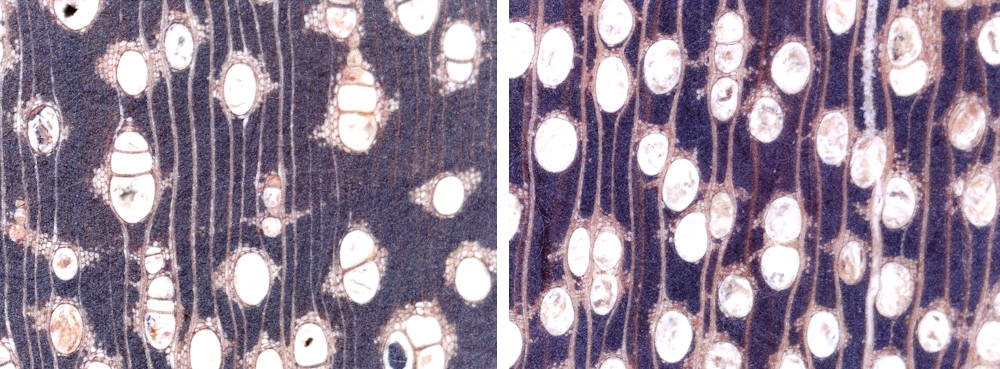Details of why I think this is not cumaru and not apitong/kuering
CUMARU --- ruled out by end grain
- DENSITY: exactly right for the weight; Dallwitz and Richter give specific gravity 0.9–1.15 g/cm³ which is 56lbs/cuft to 72lbs/cuft and m212 is about 62lbs/cuft
- FACE GRAIN: a good match for cumaru
- END GRAIN: the ray density is noticeably higher in cumaru and cumaru has at least some lozenge shaped aliform parenchyma and this wood does not
- MICRO END GRAIN: no way this is cumaru. Cumaru clearly has lozenge shaped aliform
parenchyma and m212 does not. (see images at the bottom of this page)
APITONG / KUERING --- a good match for everything but weight, but the weight discrepancy is just too much to be right.
- DENSITY: Dallwitz and Richter give: keruing (apitong) specific gravity 0.66–0.75–0.8 g/cm³ which is 41lbs/cuft to 50lbs/cuft. M212 is about 62lbs/cuft so just too heavy for keruing/apitong
- FACE GRAIN: For keruing, I have one piece to which this is a decent match and many for which it is not a good match
- END GRAIN: I get a perfect match for one of my keruing (apitong) samples at my normal 12x
- MICRO END GRAIN: keruing (apitong) is a poor match but not completely impossible. I don't have a micro end grain for the keruing (apitong) sample to which this is a good match at 12X

cumaru on the left and m212 on the right. I picked an area of cumaru with as little lozenge shaped aliform parenchyma as I could find and an area of m212 that is close as I could find to anything even remotely resembling lozenge shaped aliform parenchyma. As you can see, it's just not a match.
